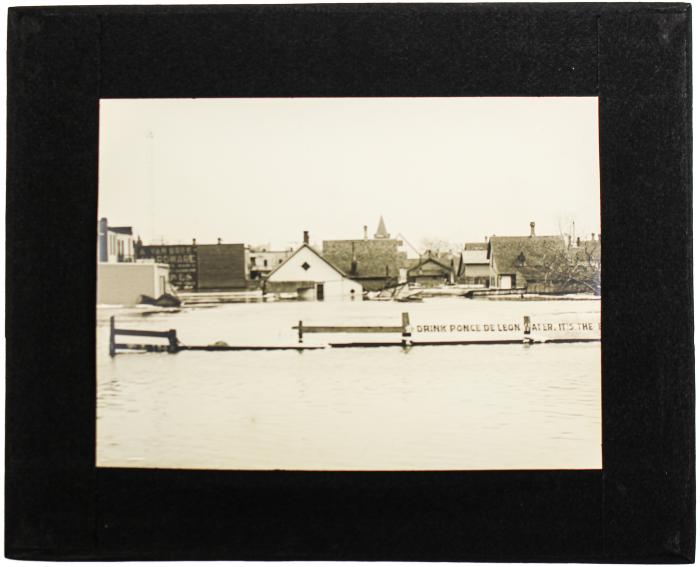Comments and Tags
Be the first to comment on this item!
Photographs
Magic Lantern Slides
Magic Lantern Slideshow - VanderVeer ➔ Lantern Slide, Flood of 1904
Identifier:
140454.5Description:
This black and white photographic lantern slide depicts a view of a flooded street almost to the roofs of houses. A sign is posted on a fence stating 'drink Ponce deL Leon water. It's the b" before the photo cuts off the rest.This slide is part of slideshow 2021.6.68 about Michigan utilized for educational purposes by the Grand Rapids Public Museum.
Date:
1904Materials:
GlassDimensions:
4" h 3.25" wCurrent Location Status:
In StorageCollection Tier:
Tier 2Source:
Gift of Harold VanderVeerRelated Entities:
Harold VanderVeer (donor) Grand Rapids Public Museum (identified by)Alternate names: Grand Rapids Lyceum of Natural History, Grand Rapids Scientific Club, GRPM, Kent Scientific Institute, Kent Scientific Museum, Public Museum of Grand Rapids, Public Museum of West Michigan
The Grand Rapids Lyceum of Natural History was established in 1854 by a group of civic leaders, inspired by a movement sweeping the country. Followers of the Lyceum Movement believed that education, in the form of libraries, museums, lectures and discussions, and public schools, could help right the illnesses of society and preserve democracy.
In the early 1860s the Civil War had put a halt to the activities of the Lyceum. But in the summer of 1865, the war was over, and the enthusiasm of a group of teenage boys for new ideas about science and nature would bring the fledgling Museum back to life.
In 1868 the Grand Rapids Lyceum of Natural History and the Grand Rapids Scientific Club merged to form the Kent Scientific Institute. The new organization successfully combined the youthful enthusiasm of local high school students with the experience of prominent civic leaders to create a successful museum for their community.
In 1881, the Kent Scientific Institute reached an agreement with the Board of Education which allowed them to store their collections at Central High School.
In February of 1903, the Board of Education agreed to purchase the Howlett House, at the corner of Jefferson and Washington, to be the permanent home of the Kent Scientific Institute.
The "new" Grand Rapids Public Museum was built during the Great Depression with WPA funds from the Federal Government. The building itself was a radical departure from most contemporary museums, and was described by Museum Director Frank DuMond as "accessible as a dime store and friendly as your next door neighbor."
The Grand Rapids Public Museum began experimenting with planetarium equipment in the early 1960s, and hired its first curator for the new technology in 1964. The planetarium was eventually named after Grand Rapids astronaut Roger B. Chaffee, who was killed in the Apollo I disaster on January 27, 1967.
In 1989, the Grand Rapids Public Museum took over the management of the Voigt House in the Heritage Hill Neighborhood. The opulent home was built in 1895 and includes more than 100 years of the Voigt family's possessions.
The Grand Rapids Public Museum's current facility opened in 1994 on the west bank of the Grand River in the heart of downtown. It contains three floors of exhibits, the Roger B. Chaffee Planetarium, the Cook Carousel Pavilion, Meijer Theater, cafe, and gift shop.
